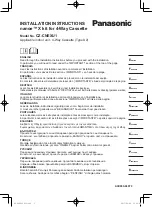
HandyTone-486 User Manual
Grandstream Networks, Inc.
26
Allow incoming SIP
messages from SIP
proxy only
If set to “Yes”, the device will ignore any SIP message that does not come from
the IP address (Source IP in the IP header) that it is registered to. Default
setting is “No”.
Use DNS SRV:
Default is “No”. If set to “Yes” the client will use DNS SRV to lookup for the
server.
User ID is Phone
Number
If set to yes, a “user=phone” parameter will be attached to the “From” header in
SIP request.
SIP Registration
This parameter decides whether the HandyTone ATA needs to send
REGISTER messages to the proxy server. The default setting is “Yes”.
Unregister on
Reboot
Default is “No”. If set to “Yes”, the device will first send registration request to
remove previous bindings.
Register Expiration
This parameter allows the user to specify the time frequency (in minutes) the
HandyTone ATA will refresh its registration with the specified registrar. The
default interval is 60 minutes (or 1 hour). The maximum interval is 65535
minutes (about 45 days).
Early Dial
Default is “No”. Use only if proxy supports 484 response.
Dial Plan Prefix
Sets the prefix added to each dialed number.
No Key Entry
timeout
Default is 4 seconds.
Use # as
Send Key
This parameter allows user to configure the “#” key to be used as the “Send”
(or “Dial”) key. Once set to “Yes”, pressing this key will immediately trigger
the sending of dialed string collected so far. If set to “No”, the “#” key will then
be included as part of the dialed string to be sent out.
Local SIP port
This parameter defines the local SIP port the HandyTone ATA listens and
transmits. The default value is 5060.
Local RTP port
This parameter defines the local RTP-RTCP port pair the HandyTone ATA
listens and transmits. It is the base RTP port for channel 0. When configured,
channel 0 will use this port_value for RTP and the por1 for its RTCP;
channel 1 will use por2 for RTP and por3 for its RTCP. The
default value is 5004.
Use Random Port
Default “No”. If set to “Yes”, the device will pick randomly-generated SIP and
RTP ports. This is usually necessary when multiple HandyTone ATAs are
behind the same NAT.















































